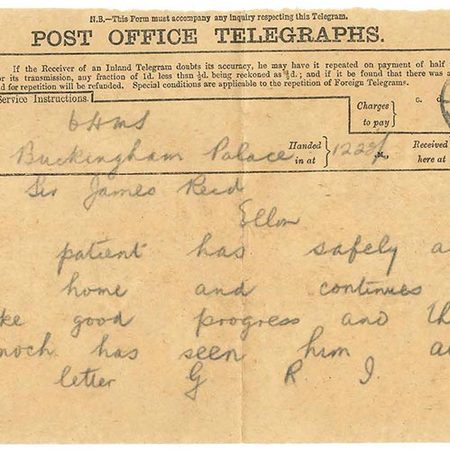Guest Collection Highlight by Dr Hilary Hinton, Honorary Librarian, Med-Chi Society

Son of the local doctor, Reid was born in 1849 in Ellon and had an outstanding academic career, graduating from Aberdeen University MB, CM 1872 and MD 1875. Working on the Continent he learned to speak German and as a result, when Queen Victoria was looking for a new Scottish medical attendant who was conversant in German, he was chosen. He remained her personal physician until her death in 1901. Sir James had retired but three weeks after the outbreak of the First World War he received notification from London telling him to go to Wick and meet Prince Albert (‘Bertie’, 1895-1952), second son of the King, George V, who had developed appendicitis while serving as a midshipman on board HMS Collingwood.
On board the hospital ship Rohilla, Sir James sailed with the Prince for Aberdeen. Travelling via Scapa Flow they passed the battleships and destroyers awaiting action. The Rohilla being too large to enter Aberdeen harbour, Prince Albert was disembarked on the 29 August in a cot by crane into a tug and brought ashore along with forty-four other invalid naval sailors. The Prince had suffered abdominal symptoms for much of his life but this time it was necessary to have his appendix removed.
Sir John Marnoch (1867-1936), Professor of Surgery operated on Albert in the Northern Nursing Home, Albyn Place on the 9 September 1914. In a letter to Reid dated 6th September the King had approved of Sir Alexander Ogston, whom Marnoch had succeeded as Professor of Surgery in 1909 (and who both held the office of President of the Med-Chi Society), also being present at the operation. The King asked Reid to send a telegram as soon as the operation was over “and telegraph twice a day for the first few days at least”. The future king made a good recovery and both the Prince of Wales and Princess Mary visited Albert in Aberdeen in the following days.
Prince Albert returned to serve on board HMS Collingwood and took part in the battle of Jutland at the end of May 1916 but continued health problems forced him to leave the navy in July 1917, although he later served as an officer in the fledgling Royal Air Force. Albert returned as Duke of York to Aberdeen in 1936 to officially open the new Infirmary building at Foresterhill.
